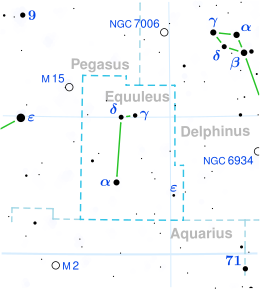| Observation data Epoch J2000.0 Equinox J2000.0 (ICRS) | |
|---|---|
| Constellation | Equuleus [1] |
| Right ascension | 21h 09m 58.2645s [2] |
| Declination | +02° 56′ 37.310″ [2] |
| Apparent magnitude (V) | 6.43±0.01 [3] |
| Characteristics | |
| Evolutionary stage | subgiant [4] |
| Spectral type | F5 IV [5] |
| U−B color index | +0.06 [6] |
| B−V color index | +0.37 [6] |
| Astrometry | |
| Radial velocity (Rv) | −42.8±2.4 [7] km/s |
| Proper motion (μ) | RA: +48.902 mas/yr [2] Dec.: +10.883 mas/yr [2] |
| Parallax (π) | 15.2530±0.3122 mas [2] |
| Distance | 214 ± 4 ly (66 ± 1 pc) |
| Absolute magnitude (MV) | +2.12 [1] |
| Details | |
| Mass | 1.45±0.23 [8] M☉ |
| Radius | 2.2±0.1 [8] R☉ |
| Luminosity | 9.147±0.21 [2] L☉ |
| Surface gravity (log g) | 3.91±0.09 [8] cgs |
| Temperature | 6,846±233 [9] K |
| Metallicity [Fe/H] | +0.09 [10] dex |
| Rotational velocity (v sin i) | 16.4±10.6 [11] km/s |
| Age | 1.21 [9] Gyr |
| Other designations | |
| 13 G. Equulei [12] , AG+02°2701, BD+02°4311, GC 29582, HD 201507, HIP 104481, HR 8095, SAO 126587 [13] | |
| Database references | |
| SIMBAD | data |
HD 201507, also designated HR 8095, is a white-hued star located in the equatorial constellation Equuleus. It has an apparent magnitude of 6.43, [3] placing it near the limit for naked eye visibility. Parallax measurements place the object at a distance of 214 light years [2] and it is currently drifting closer with a heliocentric radial velocity of −43 km/s . [7]
There have been disagreements in classifying the star's spectrum. Eugene A. Harlan found a spectral classification of F5 IV, [5] indicating that it is a F-type subgiant that is evolving towards the red giant branch. On the other hand, Nancy Houk and Carrie Swift (1999) found a class of F2 V, [14] indicating that it is still on the main sequence.
HD 201507 has 1.45 times the mass of the Sun and a slightly enlarged radius of 2.2 R☉ [8] due to its evolved state. It shines with a luminosity of about 9 L☉ [2] from its photosphere at an effective temperature of 6,846 K. [9] HD 201507 is slightly metal enriched, with a metallicity 123% that of the Sun. [10] This star has a modest projected rotational velocity of 16 km/s [11] and is estimated to be 1.21 billion years old, [9] only a quarter the age of the Sun.
